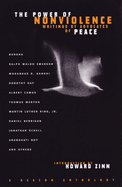 Howard Zinn‘s 1970 essay Vietnam: The Moral Equation is the seventeenth chapter of The Power of Nonviolence: Writings by Advocates of Peace . I am proponent of Zinn’s People’s History of the United States, and especially the graphic novel version, A People’s History of American Empire. And Zinn seems to be a force behind this book of pacifism, including contributing the introduction.
Howard Zinn‘s 1970 essay Vietnam: The Moral Equation is the seventeenth chapter of The Power of Nonviolence: Writings by Advocates of Peace . I am proponent of Zinn’s People’s History of the United States, and especially the graphic novel version, A People’s History of American Empire. And Zinn seems to be a force behind this book of pacifism, including contributing the introduction.
Yet, here I go committing heresy: Howard Zinn is wrong. In the first few paragraphs of this essay he gives away the whole pacifist store. Now I am all for the concept of free, but not when it means surrendering my pacifism from the get-go. Zinn starts by giving up on pacifism:
I would start such a discussion from the supposition that it is logically indefensible to hold an absolutely nonviolent position . . . .
I disagree. Always start from an absolutely nonviolent position. I have found that there are enough people who argue for violence. Pacifists don’t need to make their arguments for them. We must make the killers prove their case.
When it comes up in conversation that I am a pacifist, some people are threatened by that. They immediately reach for Godwin’s Law, invoking Hitler as the example when violence is needed, in the hopes that their Reductio ad Hitlerum will end my pacifism. I remind them that World War II ended 65 years ago. I point out that the subtext of what they are saying is that the US has not engaged in any war over those 65 years that was worth the cost. They do not disagree. I suggest to them that if the US had started from a position of absolute nonviolence over those past 65 years, then millions of unnecessary deaths could have been avoided. They usually walk off thinking to themselves.
Zinn then sets out a 4-part test to determine if violence is called for. I will not bother with his test. The terms don’t matter. As we all now know the “facts” can be “fixed” to meet any test for violence. Once violence is set as the prize, it does not matter what kind of test Zinn sets in front of it to lock it up. Those who profit from violence will find a way to pick the lock. We just have to look to Secretary of State Colin Powell’s speech to the UN to see an example of violent burglary.
[youtube=http://www.youtube.com/watch?v=d93_u1HHgM4]
Zinn’s violence test then forces him to waste his energy in refuting the following four categories of government propoganda in favor of violence. This creates a thicket of distractions in proving minute points. Zinn’s violence test distracts us from the real point. We should be focused on nonviolence. Period.
- History of violence. Zinn’s violence test devolves into the chicken and egg argument with the US of who was the aggressor in the Vietnam conflict. Zinn cites his sources to rebut the US government sources. I find that Zinn’s focus on the history of violence focuses us on trying to determine whose history is the correct one, rather than achieving nonviolence.
- Ideology. Zinn wastes much time parsing the so-called differences between capitalistic and communist systems. And then he has to further parse the difference between communism in theory and in practice. I find that this ultimately paints him as an ideological partisan, whose opposition to violence is based upon his favortism for a particular political system over another, rather than a policy of nonviolence toward all.
- Permanent Enemy. A permanent enemy for a fascist regime. As in George Orwell‘s 1984, Zinn describes the effortless shift in the US of the permanent enemy from the Soviet Union to China. I find With Zinn’s violence test creates a space for an enemy. To me, this means that once you allow for violence, then you allow for a target of the violence: an enemy. I would rather start from a point of absolute nonviolence, which leaves no room for an enemy, much less a permanent enemy.
- Betrayal of values. Zinn describes the underlying values that 20th century countries “claim to uphold: self-determination, economic security, racial equality, freedom” He describes the US government’s actions as a betrayal of these values. I find the betrayal of values argument to to resemble the history of violence argument: Zinn is again entering a competition of realities and a battle of choosing between multiple incidents and minute facts. Again, I return to a policy of absolute nonviolence which steers away from these distractions, and sets a clear measure.
The road to freedom is stony, but people are going to march along it. What we need to do is improve that road, not blow it up.
Related
- What’s in your Occupy Handbook?
- Howard Zinn meets Ace Ventura starting 6/3/11
- Sad news: Howard Zinn died today (1/27/2010)
- Animated Graphic Novel of People’s History of American Empire by Howard Zinn

